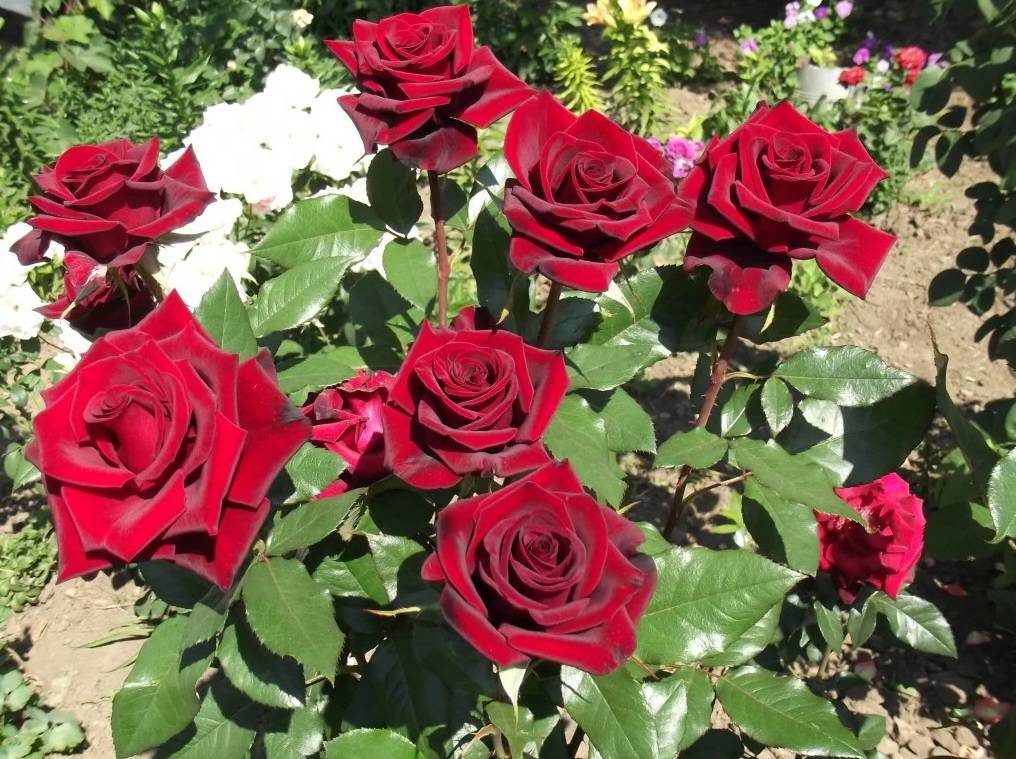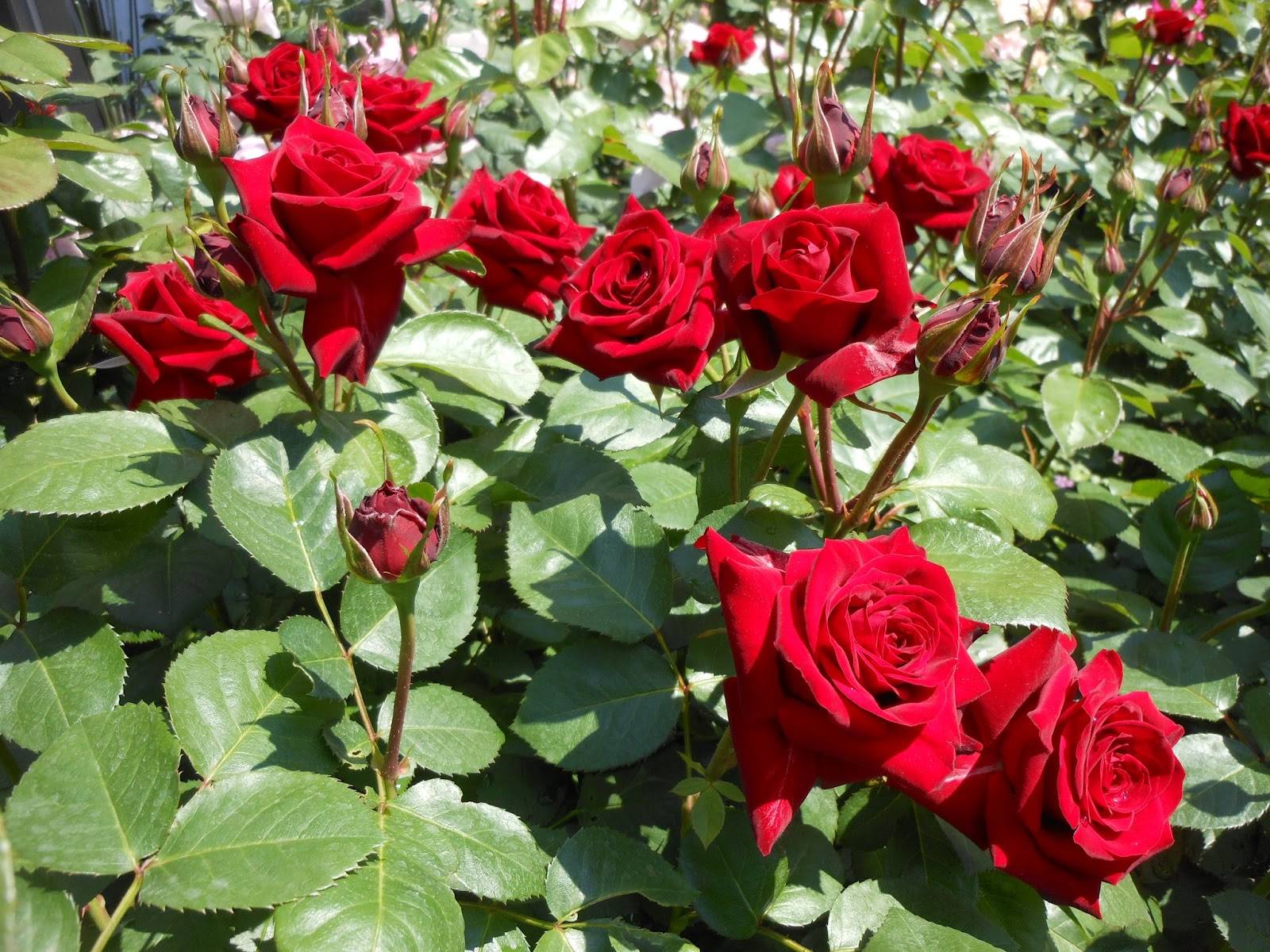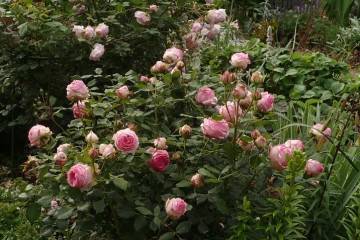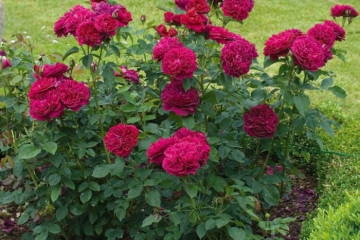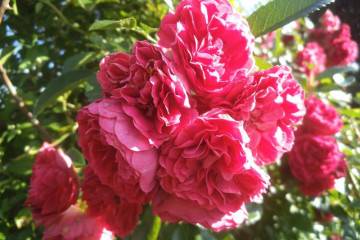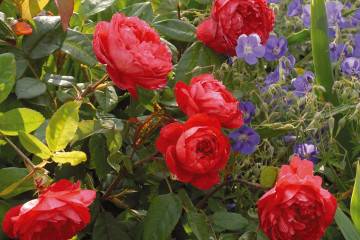Rosa Explorer (Explorer) - description of the varietal culture
Content:
Gardeners who are fond of breeding exquisite varieties with large, densely double flowers, strive to get the Explorer rose in their collections. This variety, adapted for cultivation in Russian latitudes, is able to become the heart of a flower garden.
Rose Explorer (Explorer): description and characteristics
Rosa Explorer, classified as a cut-off, was bred by breeders of the Dutch rose-growing company Interplant Roses. It appeared not so long ago, in 2015. In specialist circles, it is also known as INTeronotov.
The plant forms a compact and neat bush with a height of about 1 m. Shoots are erect, directed vertically upward, covered with dark green leaves of regular shape with a glossy sheen. The buds have a goblet shape, painted in a dense burgundy-velvety shade, when fully opened they reach 11-13 cm in diameter. There is no aroma.
In landscape design, single plantings of this perennial are used. A properly formed bush looks great against the background of an emerald lawn.
How to properly plant in open ground and grow a flower
How the Explorer rose will grow and develop largely depends on the correct planting. Only knowledge and adherence to all the subtleties will allow you to grow a healthy, abundantly flowering plant.
Spring is considered the optimal time for planting, then the flower will have enough time for adaptation and rooting. You can also plant the Explorer in September-October, when there are still a few weeks before frost.
Seat selection
The explorer prefers high ground areas that are sheltered from gusts of wind. Too close location of groundwater can lead to decay of the root system.
How to prepare the soil and flower for planting
Before planting, the soil is dug up in advance with the addition of organic matter. The soil must be sufficiently loose and drained.
Step-by-step planting procedure
The landing itself must take place in a specific sequence. It is recommended to proceed as follows:
- Dig planting holes 70 × 70 cm.
- Mix humus, ash and compost to the ground.
- Lay drainage at the bottom of the pit and sprinkle it with a heap of earth.
- Place the seedling in the hole, gently spreading the roots.
- Cover the hole with soil without leaving any air pockets.
- Water the planting site with warm water.
Plant care
Despite the relative unpretentiousness, the Explorer requires some attention.To keep the plant healthy, it will have to be properly cared for.
Watering rules and humidity
The variety is drought-resistant, but in the summer heat it needs watering once a week. After a couple of days, the soil under the bush is loosened to retain moisture and saturate the roots with oxygen.
Top dressing and soil quality
A neutral acidic soil is suitable for the explorer. Adding humus and wood ash will not be superfluous. For abundant flowering, Explorer needs to be fed with special mineral compounds, including nitrogen, potassium and phosphorus.
Pruning and replanting
Rejuvenating pruning is carried out no more than 1 time in 2-3 years, removing in the spring old shoots that have had time to woody. Formative pruning is not needed for a naturally compact bush.
Features of wintering a flower
For the winter, the bush is well spud and mulched with compost soil. The branches are bent to the ground and covered with non-woven material. In winter, the rose is sprinkled with an additional snow pillow, and in March they begin to air it so that the plant does not get wet.
Blooming rose
Explorer blooms several times during the season in waves. At this time, the bushes are evenly covered with single wine-red buds.
A period of activity and rest
The Explorer blooms much earlier than most varietal roses. The first wave of bud formation and the opening of flower-bowls occurs in mid-May. After each period of lush and abundant flowering, the plant rests.
Care during and after flowering
During flowering, faded corollas should be promptly removed so as not to spoil the decorative effect of the plant.
What to do if it does not bloom
Sometimes it can happen that the Explorer refuses to bloom. The reasons for this are:
- plant age (too young or old);
- wrong landing site;
- untimely pruning, in which flower buds have suffered;
- root shoots (in grafted specimens);
- violation of the rules of care;
- bacterial burn.
If all these problems are eliminated, then you can try to stimulate the bush by removing weak shoots and adding potassium and humates.
Flower propagation
The easiest way to propagate Explorer is by cuttings. This is a tried and tested method that always gives good results.
To prepare cuttings, choose viable shoots and cut off a little more than 20 cm from them.All leaves are removed from the segments, except for the top 2. Next, the cuttings are planted in the prepared groove, deepening to the first leaf. The distance between the seedlings should be at least 40 cm. They are covered with a small greenhouse, regularly moistened and ventilated.
Diseases, pests and ways to control them
The main harm to the Explorer is caused by sawfly larvae, rose-colored aphids and caterpillars. To combat parasites, experienced gardeners use insecticidal preparations rogor, karbofos or antio. Preventive treatment of bushes is carried out in the spring, before the buds appear.
Compliance with the described requirements will allow you to turn Explorer into a stunning beauty bush. In gratitude for the care, the rose will delight with abundant flowering throughout the season.

